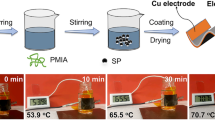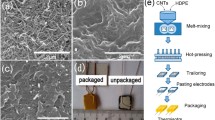Abstract
Conductive polymer composites (CPCs) as the thermo-sensitive materials have attracted much attention in thermal control field due to their reliable self-regulating behaviors, high efficiency and mechanical flexibility. However, the development of these materials needs to manage the normal conflicting requirements, such as effective heating performance and good self-regulating capability. This paper presents a series of novel CPCs material having different amounts of hybrid fillers of multi-walled carbon nanotubes (CNTs) and carbon black (CB). The positive temperature coefficient intensity is enhanced to 105.2, and the room-temperature resistivity is optimized to 320 Ω cm. Besides, the Curie temperatures are regulated to room-temperature range by incorporating the low-melting-point blend matrix into the poly(ethylene-co-vinyl acetate)/CNTs/CB composite. The thermal-control experiment demonstrates that CPCs-heating elements can adjust the equilibrium temperature of controlled equipment near their Curie temperatures without any control methods. Compared with the ordinary resistor, the CPCs materials have the remarkable adaptive thermal control behavior. Furthermore, the temperature control capability is particularly prominent in the changing environment temperature. The CPCs as a safe and reliable adaptive heating element is potential to replace the conventional active thermal control means.
Similar content being viewed by others
References
Hou Z, Hu J. Thermal Control Technology of Spacecraft—Principles and Applications (in Chinese). Beijing: China Science and Technology Press, 2008. 23–276
Desouky M A A, Abdelkhalik O. Improved spacecraft magnetic attitude maneuvering. J Spacecr Rockets, 2019, 56: 1611–1623
Liang C, Liu Y, Ruan Y, et al. Multifunctional sponges with flexible motion sensing and outstanding thermal insulation for superior electromagnetic interference shielding. Compos Part A-Appl Sci Manuf, 2020, 139: 106143
Zhang C, Ma C A, Wang P, et al. Temperature dependence of electrical resistivity for carbon black filled ultra-high molecular weight polyethylene composites prepared by hot compaction. Carbon, 2005, 43: 2544–2553
Lisunova M O, Mamunya Y P, Lebovka N I, et al. Percolation behaviour of ultrahigh molecular weight polyethylene/multi-walled carbon nanotubes composites. Eur Polym J, 2007, 43: 949–958
Yu A, Li Q. Temperature-dependent resistivity performance of Mn/Y-doped Ba1Sr TiO3 compositions with potential thermal control applications. Ceramics Int, 2020, 46: 8796–8805
Bin Y, Xu C, Zhu D, et al. Electrical properties of polyethylene and carbon black particle blends prepared by gelation/crystallization from solution. Carbon, 2002, 40: 195–199
Di W, Zhang G, Peng Y, et al. Two-step PTC effect in immiscible polymer blends filled with carbon black. J Mater Sci, 2004, 39: 695–697
Chen Z, Hsu P C, Lopez J, et al. Fast and reversible thermoresponsive polymer switching materials for safer batteries. Nat Energy, 2016, 1: 15009
Liang C, Ruan K, Zhang Y, et al. Multifunctional flexible electromagnetic interference shielding silver nanowires/cellulose films with excellent thermal management and joule heating performances. ACS Appl Mater Interfaces, 2020, 12: 18023–18031
Yang X, Fan S, Li Y, et al. Synchronously improved electromagnetic interference shielding and thermal conductivity for epoxy nanocomposites by constructing 3D copper nanowires/thermally annealed graphene aerogel framework. Compos Part A-Appl Sci Manuf, 2020, 128: 105670
Coleman J, Khan U, Gun’ko Y. Mechanical reinforcement of polymers using carbon nanotubes. Adv Mater, 2006, 18: 689–706
Li Q, Basavarajaiah S, Kim N H, et al. Synergy effect of hybrid fillers on the positive temperature coefficient behavior of polypropylene/ultra-high molecular weight polyethylene composites. J Appl Polym Sci, 2010, 116: 116–124
Zha J W, Li W K, Liao R J, et al. High performance hybrid carbon fillers/binary-polymer nanocomposites with remarkably enhanced positive temperature coefficient effect of resistance. J Mater Chem A, 2013, 1: 843–851
Wang L, Shi X, Zhang J, et al. Lightweight and robust rGO/sugarcane derived hybrid carbon foams with outstanding EMI shielding performance. J Mater Sci Tech, 2020, 52: 119–126
Stoll R, Williams L. Thermal design and testing of the Hubble Space Telescope fine guidance system and wavefront sensor. In: Proceedings of the 4th Thermophysics and Heat Transfer Conference. Boston, 1986. 1–6
Cheng W, Yuan S, Song J. Studies on preparation and adaptive thermal control performance of novel PTC (positive temperature coefficient) materials with controllable Curie temperatures. Energy, 2014, 74: 447–454
Huang Y H, Cheng W L, Zhao R. Thermal management of Li-ion battery pack with the application of flexible form-stable composite phase change materials. Energy Convers Manage, 2019, 182: 9–20
Cheng W, Song J, Liu Y, et al. Theoretical and experimental studies on thermal control by using a novel PTC material with room temperature Curie point. Int J Heat Mass Transfer, 2014, 74: 441–447
Cheng W, Zhang R, Xie K, et al. Heat conduction enhanced shape-stabilized paraffin/HDPE composite PCMs by graphite addition: Preparation and thermal properties. Sol Energy Mater Sol Cells, 2010, 94: 1636–1642
Zhang Q H, Chen D J. Percolation threshold and morphology of composites of conducting carbon black/polypropylene/EVA. J Mater Sci, 2004, 39: 1751–1757
Yu G, Zhang M Q, Zeng H M, et al. Conductive polymer blends filled with carbon black: Positive temperature coefficient behavior. Polym Eng Sci, 1999, 39: 1678–1688
Yang Q Q, Liang J Z. Electrical properties and morphology of carbon black-filled HDPE/EVA composites. J Appl Polym Sci, 2010, 117: 1998–2002
Chen R, Bin Y, Zhang R, et al. Positive temperature coefficient effect of polymer-carbon filler composites under self-heating evaluated quantitatively in terms of potential barrier height and width associated with tunnel current. Polymer, 2012, 53: 5197–5207
Kilbride B E, Coleman J N, Fraysse J, et al. Experimental observation of scaling laws for alternating current and direct current conductivity in polymer-carbon nanotube composite thin films. J Appl Phys, 2002, 92: 4024–4030
Liang G D, Tjong S C. Electrical properties of low-density polyethylene/multiwalled carbon nanotube nanocomposites. Mater Chem Phys, 2006, 100: 132–137
Zeng Y, Lu G, Wang H, et al. Positive temperature coefficient thermistors based on carbon nanotube/polymer composites. Sci Rep, 2015, 4: 6684
Tchoudakov R, Breuer O, Narkis M, et al. Conductive polymer blends with low carbon black loading: Polypropylene/polyamide. Polym Eng Sci, 1996, 36: 1336–1346
Sumita M, Sakata K, Asai S, et al. Dispersion of fillers and the electrical conductivity of polymer blends filled with carbon black. Polym Bull, 1991, 25: 265–271
Pang H, Chen Q Y, Bao Y, et al. Temperature resistivity behaviour in carbon nanotube/ultrahigh molecular weight polyethylene composites with segregated and double percolated structure. Plastics Rubber Compos, 2013, 42: 59–65
Li Q, Siddaramaiah Q, Kim N H, et al. Positive temperature coefficient characteristic and structure of graphite nanofibers reinforced high density polyethylene/carbon black nanocomposites. Compos Part B-Eng, 2009, 40: 218–224
Baltá Calleja F J, Bayer R K, Ezquerra T A. Electrical conductivity of polyethylene-carbon-fibre composites mixed with carbon black. J Mater Sci, 1988, 23: 1411–1415
Author information
Authors and Affiliations
Corresponding author
Additional information
This work was supported by the National Natural Science Foundation of China (Grant No. 51225602).
Rights and permissions
About this article
Cite this article
Yu, A., Li, Q. Studies on preparation and thermal control behavior of hybrid fillers/binary-polymer composites with positive temperature coefficient characteristic. Sci. China Technol. Sci. 64, 1447–1458 (2021). https://doi.org/10.1007/s11431-020-1830-2
Received:
Accepted:
Published:
Issue Date:
DOI: https://doi.org/10.1007/s11431-020-1830-2




